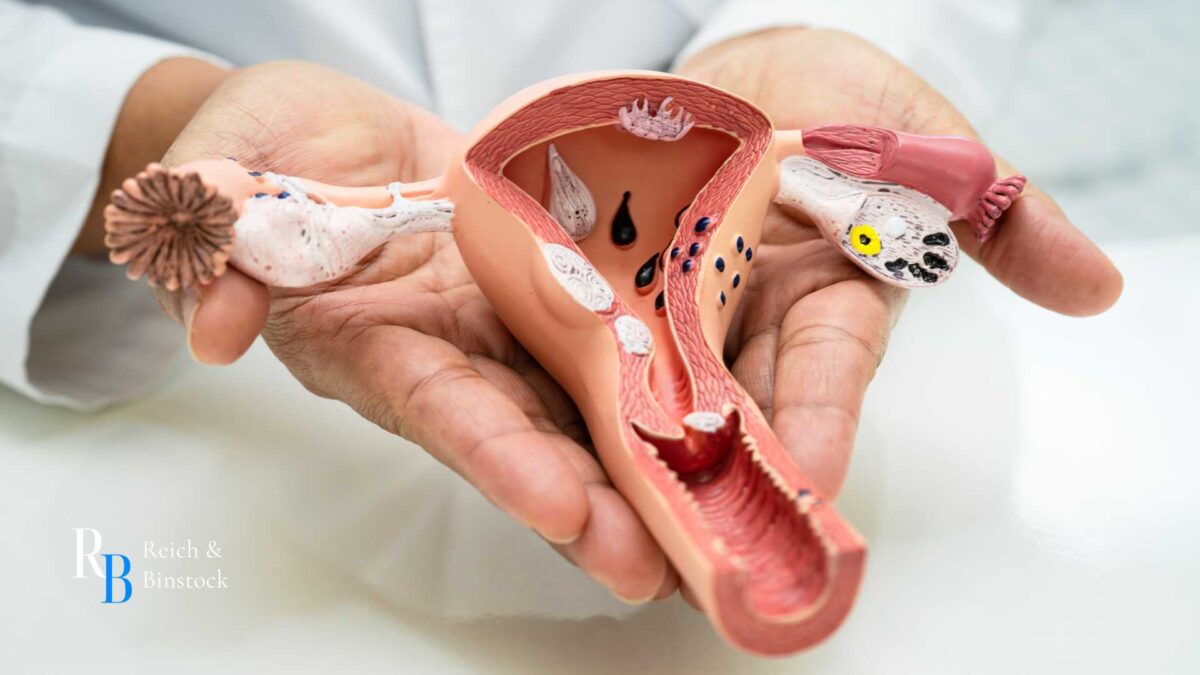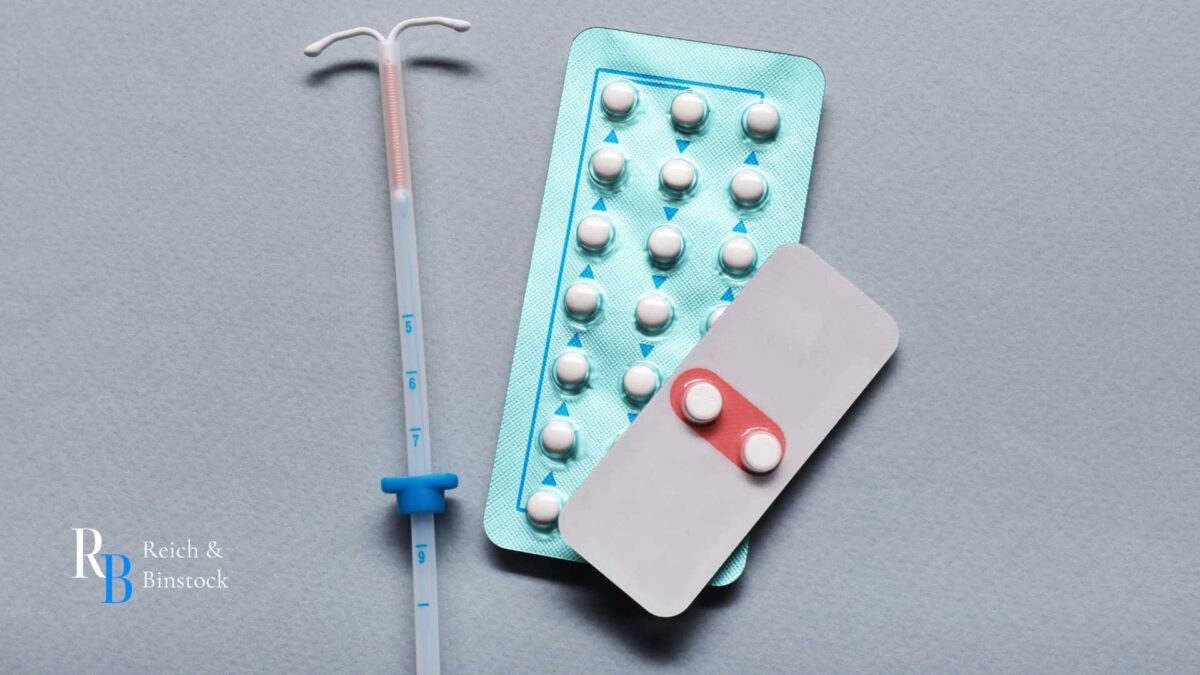IUD perforation symptoms may be the first sign of a serious complication involving a defective intrauterine contraceptive device or improper IUD insertion. When an intrauterine device punctures the uterine wall or migrates into the abdominal cavity, it can damage abdominal organs, like the bowel or bladder, often requiring emergency laparoscopic removal or even open abdominal surgery.
Our Texas defective medical device lawyers investigate cases involving intrauterine device complications, including patients who suffered bowel perforation, ectopic pregnancy, or permanent injuries after a perforated IUD was discovered.
If you or a loved one were injured or required surgical IUD removal, call Reich & Binstock at 713-622-7271 or fill out our secure contact form to schedule your free consultation.
What Is an Intrauterine Contraceptive Device and How Do Intrauterine Devices (IUDs) Work?
An intrauterine device is a type of long-lasting contraception inserted directly into the uterus by a doctor. Skyla, Liletta, Kyleena, and Mirena are hormonal IUDs, while Paragard is a non-hormonal copper intrauterine device. Mirena is the most common levonorgestrel-releasing intrauterine system. Intrauterine contraception prevents pregnancy by limiting the movement of sperm by thickening the mucus in the cervix. It’s also believed to thin the uterine lining.
IUDs must be inserted and removed through the cervix by a physician. Surgery is only needed if complications arise. IUDs can last for many years. For example, the Mirena IUD lasts about 5 years, and the copper Paraguard is good for 10 years. IUDs usually have a 99.7% effectiveness rate. An added bonus is the lack of user error that exists with other types of birth control.
Uterine Perforation IUD Symptoms: Recognizing Serious Complications With Birth Control Devices
IUD perforation symptoms are the most serious patient complaints, since they can lead to potentially fatal infections if not treated. This can occur during IUD insertion or if the device moves within the body. Some cases report asymptomatic patients, others notice physical warnings after insertion, but in most cases, it takes months or years to present with pelvic pain or severe cramping.
There are two types: partial and complete.
Symptoms of IUD Perforation : Complete
Complete IUD perforation symptoms may include severe abdominal pain, persistent pelvic pain, and missing or non-palpable strings. When a levonorgestrel releasing intrauterine system or intrauterine contraceptive device fully punctures the uterine wall, it can migrate into the abdominal cavity, causing injury to the bowel, bladder, sigmoid colon, or other organs.
Patients may develop symptoms of bowel perforation, intestinal obstruction, or infection. In many cases, the perforated IUD must be located with ultrasounds or x-ray, followed by surgical intervention to remove the IUD.
If left untreated, a this type of uterine perforation can result in permanent damage, infertility, or the need to remove the IUD in the emergency department.
Symptoms of Partial Perforation
Partial IUD perforation symptoms may be more subtle than complete perforation but can still lead to intrauterine device complications. Patients often report pain in the pelvis, abdominal pain, or discomfort during sex or physical activity. The strings may appear shortened, uneven, or difficult to locate, suggesting the intrauterine contraceptive device has embedded into the uterine wall without fully entering the abdomen. This type of intrauterine device complication can go unrecognized, especially in asymptomatic patients, and may be discovered only during imaging or attempted IUD removal. A partial perforated IUD increases the risk of ectopic pregnancy, bleeding, infection, and may still require surgical removal, depending on its position and impact on surrounding tissue.
Intrauterine Device Perforating vs IUD Moving
Complete or partial perforations are different from an IUD moving out of place. An intrauterine device perforating can harm the organs and requires surgical removal in many case reports.
In contrast, IUD out of place symptoms include abdominal pain or sore pelvis, irregular bleeding, or not being able to find the strings. However, the intrauterine device (IUD) may still be in the uterus. An ultrasound or computed tomography helps determine whether the IUD is displaced or intra-abdominal.
Postpartum Period IUD Insertion and Perforation Risk Factors
Postpartum period IUD insertion carries a higher risk of uterine perforation, especially within the first few weeks postpartum when the area is still soft and thin. Hormonal changes, breastfeeding, and recent birth can all increase vulnerability to complications. Although having the intrauterine device (IUD) inserted early is often recommended for preventing pregnancy, proper timing and technique are critical for prevention of a perforated IUD or migration.
IUD Strings: What May Indicate IUD Perforation
Changes in IUD strings, such as threads that are missing, shorter, longer, or uneven, are a common early signal for IUD perforation. Others may include pelvic pain, abdominal pain, unexpected bleeding, or pain during sex. If the intrauterine device (IUD) perforated, symptoms may progress or remain unnoticed in asymptomatic patients.

I Can Feel My IUD in My Uterus: What This Might Mean
If you can feel your intrauterine device (IUD), this may indicate that it is low-lying, improper insertion, or partial expulsion. While some awareness of the threads is normal, feeling the actual plastic itself may suggest misplacement or a partial IUD perforation.
Mirena IUD Perforation Symptoms
Mirena IUD perforation symptoms may include cramping, vaginal bleeding, and the inability to detect the strings during a physical examination. In some cases, the levonorgestrel releasing intrauterine system may become embedded or subject to partial expulsion, especially during the postpartum period. If the IUD enters the peritoneal cavity, patients may experience infection, fever, or chills, even without immediate pain. Serious outcomes like ectopic pregnancy, miscarriage, or infertility have been reported with such Mirena IUD injuries.
IUD Embedded in Uterus Symptoms
When an IUD is embedded in the Uterus, patients may experience sharp pain in the pelvis, abnormal bleeding, and resistance during attempted IUD removal. Patients may also report discomfort during intercourse or notice threads are shorter or immobile. An IUD embedded in the uterine wall can cause inflammation, scarring, and long-term intrauterine device complications, sometimes requiring surgical removal by hysteroscopy or laparoscopy.
Copper IUD in Uterus: Signs of Injury or Misplacement
Patients with a copper IUD in their uterus may present with sharp abdominal pain, pelvic pain, or heavy bleeding after insertion. Those with misalignment, embedding, or expulsion may not be able to feel their threads or experience painful intercourse. In rare case reports, copper IUDs can migrate, increasing the risk of bowel injury or infection.

How IUD Perforation Is Diagnosed
IUD perforation is first suspected when strings are missing or when patients present with abdominal pain or infection. Diagnosis of IUD perforation symptoms involves physical examination, vaginal ultrasonography, and computed tomography or x-ray to confirm whether the intrauterine contraceptive device has migrated or perforated.
Treatment depends on the location and severity of the injury.
Laparoscopic Removal of Perforated IUD
When an IUD perforates the uterine wall and enters the abdomen, a laparoscopy is the preferred method, as it uses small incisions and a camera to locate and extract the IUD without the need for open abdominal surgery. This minimally invasive procedure reduces the risk of adhesions, shortens recovery time, and is effective when the IUD has not injured major organs.
Surgery for Uterine Perforation Symptoms
For cases where the IUD embeds in or has partially perforated the uterus, the surgical approach depends on location and depth. If the IUD is still within the uterine wall, hysteroscopy may be used to visualize and remove it. When the IUD has passed through the uterine layers but not reached the abdomen, the laparoscopy method is sufficient.
In rare cases involving severe bleeding, structural damage, or failed attempts with minimally invasive procedures, an open laparotomy may be required.
Surgery for Bowel Perforation Symptoms
When IUD perforation causes damage to the bowel, sigmoid colon, or small bowel, more complex surgical removal is necessary. Patients may require laparotomy for direct access and repair, especially in cases involving intestinal obstruction, infection, or fecal contamination. If the injury is contained and the patient is stable, a laparoscopy may be attempted first. Additional procedures may include bowel resection, colostomy, or targeted repair of the damaged organ. Diagnostic imaging and sometimes colonoscopy are used to identify the extent of damage before procedures. Prompt treatment is critical to prevent sepsis or permanent complications.

Case Reports of Common IUD Injuries
Despite the great results, many women experience complications from their IUD. While uncommon, IUDs sometimes get stuck. IUDs can be hard to remove if this happens.
A more serious complication is uterine perforation and bowel perforation. This is when the IUD moves or migrates in the abdominal cavity. It’s possible for the IUD to puncture the bowel, bladder, or other organs. Abdominal surgery may be the only way to get it out. Adhesions (bands of scar tissue) are also a concern. Future pregnancies are threatened in some cases.
Additionally, once the device fully pushes through the uterus, it can travel to other parts of the body. Some women also suffer damage to the cervix, fallopian tubes, or abdominal organs such as the bladder or intestines in addition to uterine perforation.
Other possible injuries include:
- Sepsis
- Pelvic Inflammatory Disease or PID
- Abnormal bleeding
- Abscesses
- Indefinite pelvic pain
In the worst cases, surgical removal or laparoscopic removal of the IUD occurs. Surgical repair of damaged organs and/or a hysterectomy could be necessary. Surgically-treated symptomatic patients may be eligible for compensation for their injuries.
Complications From Bowel or Uterine Perforation
Bowel and uterine perforation are rare consequences of IUD insertion. They only occur in every 1,000 procedures. To limit the danger of potentially permanent complications for women, surgical treatment for bowel or uterine perforation is needed right away.
Delayed treatment causes several complications. These include scarring or tearing, organ damage, hemorrhage or bleeding, infection or sepsis, miscarriage, ectopic pregnancy, and infertility.
Texas Perforated IUD Lawyers
Many patients experience IUD perforation symptoms or harm by an IUD. Have you been denied medical care because your IUD isn’t in the right place? Please contact our Houston personal injury lawyers at 713-622-7271 for a free and confidential consultation about your legal options. We represent people all around the country with defective medical device injuries from IUDs.













